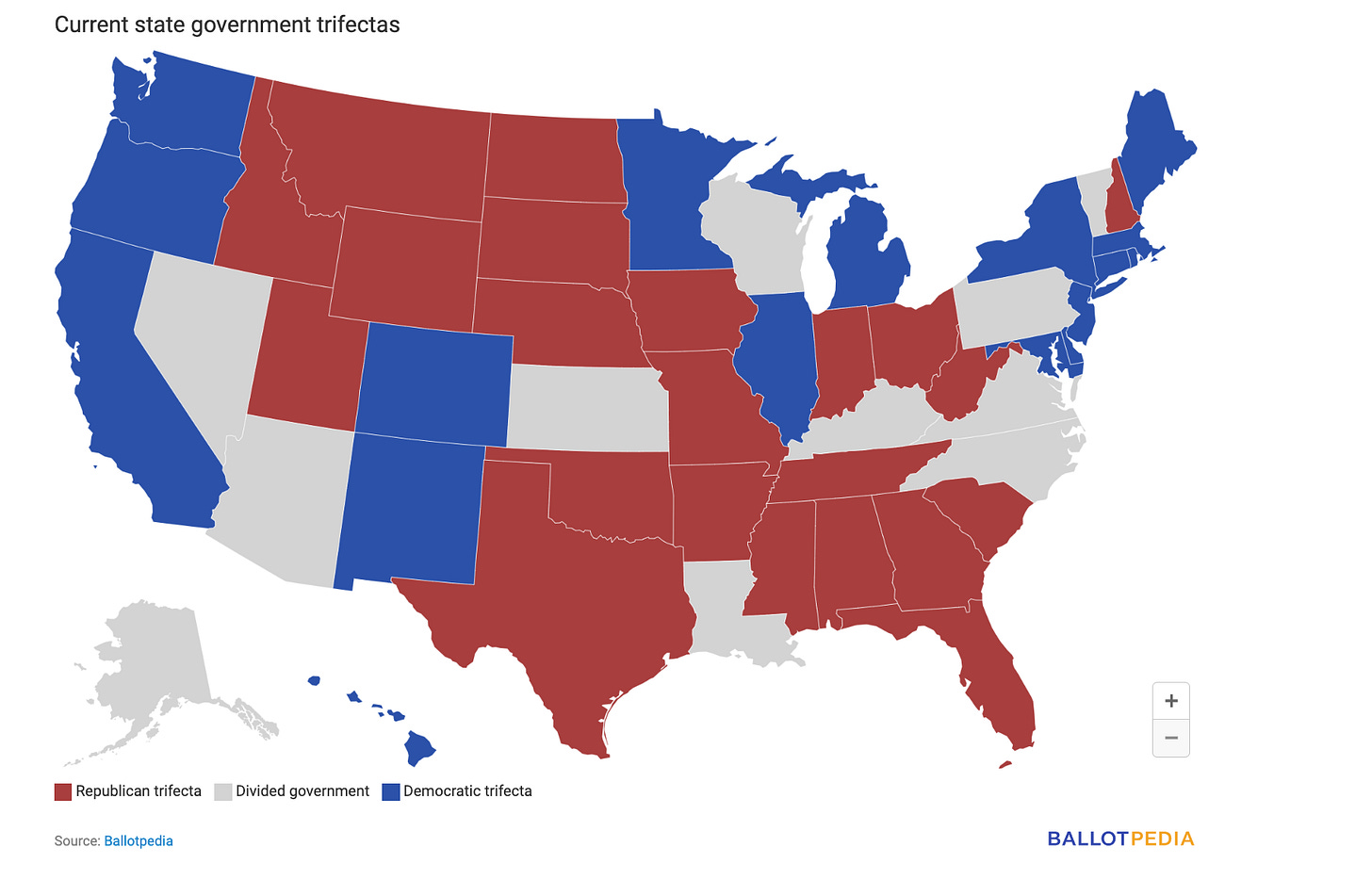This essay summarizes why physicians practicing in states with abortion bans (red in the map below) should consider moving to states that support abortion rights (gray). Note that the status of abortion laws may change.

Typically, states with abortion bans have Republican trifectas (Republican party control of the governorship, state senate and state house).

Why consider moving:
1. In these anti-abortion rights states, physicians, particularly OBGYNs, cannot always practice medicine according to the standard of care because doing so may violate state law and subject them to criminal charges.
Since the Dobbs decision, half of OBGYNs practicing in states where abortion is banned say they have had patients in their practice who were unable to obtain an abortion they sought. This is the case for one in four (24%) office-based OBGYNs nationally.
Nationally, one in five office-based OBGYNs (20%) report they have personally felt constraints on their ability to provide care for miscarriages and other pregnancy-related medical emergencies since the Dobbs decision. In states where abortion is banned, this share rises to four in ten OBGYNs (40%).
Four in ten OBGYNs nationally (44%), and six in ten practicing in states where abortion is banned or where there are gestational limits, say their decision-making autonomy has become worse since the Dobbs ruling. Over a third of OBGYNs nationally (36%), and half practicing in states where abortion is banned (55%) or where there are gestational limits (47%), say their ability to practice within the standard of care has become worse.
Most OBGYNs (68%) say the ruling has worsened their ability to manage pregnancy-related emergencies. Large shares also believe that the Dobbs decision has worsened pregnancy-related mortality (64%), racial and ethnic inequities in maternal health (70%) and the ability to attract new OBGYNs to the field (55%). Source: KFF.
2. Physicians may not want to practice in states whose laws often delay care for pregnancy complications or force women or girls to carry a fetus to term even when it has a minimal chance of survival. See, for example, Baby without kidneys and underdeveloped lungs, Baby with anencephaly (brain and skull not fully developed).
To watch [as a physician] as someone gets sicker, their hands tied not by lack of resources but by legal risk of criminal prosecution. To be silenced in the face of atrocity. The ever-present threat of losing your medical license and livelihood – or worse. Not for engaging in criminal misconduct, but instead for providing or advocating for lifesaving health care, the basic tenets of our physician oath. Source: USA Today.
3. These anti-abortion rights states are blaming physicians for pregnancy related problems by claiming that physicians misinterpret the laws, even though these laws provide little guidance to physicians on whether they apply to particular situations. Thus, physicians are in a no-win situation - either be threatened with a felony for providing needed care or tolerate patients having bad results if they do not.
4. Some of these states are attempting to impose gag laws to target physician speech about reproductive rights, which impacts not only patient access to critical medical services but also the fundamental underpinnings of the physician-patient relationship. Physicians may be forced to speak in “code” because these laws criminalize referrals to other states for abortions.
Abortion opponents don’t merely want to ban abortion. They want to silence the doctors who bear witness to the disastrous consequences of such cruel and unjust legislation. Source: New York Times.
See also the statement from Dr. Caitlin Bernard, who was recently blocked from receiving a state award by the Governor for speaking out.
5. The Attorneys General of many of these states want to violate patient privacy by obtaining the private medical records of patients who obtain abortions in other states to ultimately prosecute them.
6. In these anti-abortion rights states, the situation for physicians, women and girls is getting worse, not better. Despite the unpopularity of abortion bans, these state governments are doubling down and imposing additional and stricter treatment bans. Many are even considering bans on birth control.
7. As a result, physicians are leaving red states (see also here) and recruitment of academics and medical residents is becoming more difficult. This will make medical practice more difficult for those that stay.
8. I previously suggested that physicians in anti-abortion states consider moving to Michigan or another pro-abortion rights state. As physicians leave, it may encourage state voters or elected officials to change their views on the reproductive rights of women and girls.
Index to Nat’s Substack articles
If you like these essays, please share them with others.
Follow me on Substack or LinkedIn or through our Curing Cancer Newsletter.
Follow our Curing Cancer Network on LinkedIn and Twitter. Each week we post interesting cancer related images of malignancies with diagnoses.
Latest versions of our cancer related documents:
American Code Against Cancer (how you can prevent cancer)
Email me at Nat@PathologyOutlines.com - unfortunately, I cannot provide medical advice.
I also publish Notes at https://substack.com/note. Subscribers will automatically see my notes.
Other social media - Tribel: @nat385440b, Instagram / Threads: npernickmich



